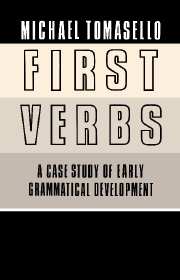Book contents
- Frontmatter
- Contents
- Acknowledgments
- Dedication
- 1 Introduction
- 2 In the beginning was the verb
- 3 Methods and an introduction to T's language
- 4 Change of state verbs and sentences
- 5 Activity verbs and sentences
- 6 Other grammatical structures
- 7 The development of T's verb lexicon
- 8 The development of T's grammar
- 9 Language acquisition as cultural learning
- References
- Appendix
- Index
4 - Change of state verbs and sentences
Published online by Cambridge University Press: 18 December 2009
- Frontmatter
- Contents
- Acknowledgments
- Dedication
- 1 Introduction
- 2 In the beginning was the verb
- 3 Methods and an introduction to T's language
- 4 Change of state verbs and sentences
- 5 Activity verbs and sentences
- 6 Other grammatical structures
- 7 The development of T's verb lexicon
- 8 The development of T's grammar
- 9 Language acquisition as cultural learning
- References
- Appendix
- Index
Summary
Six groups of expressions make up T's change of state verbs: (1) presence, absence, and recurrence of objects; (2) presence, absence, and recurrence of activities; (3) exchange and possession of objects; (4) location of objects; (5) movement of objects; and (6) state of objects. In the six sections of this chapter, I provide a discursive summary of T's use of the particular verbs that fall into each of these six categories (along with some notes on parental usage) – a total of 78 relational words and verbs. I should emphasize at the outset that these categories are not meant to depict anything in T's grammar but are meant only to be heuristics to aid researchers in categorizing the individual verbs. For readers who are interested only in a brief account of individual verbs, each of the six sections ends with a summary text, figure, and table that provide an overview of the semantics and syntax of the verbs falling into that category. An exhaustive list of the diary entries on which these summaries and analyses are based is given in the appendix, organized into the same six sections as the text. Examples from T's speech are often accompanied by a specification of her age in months and days, for example, 19.22.
Presence, absence, and recurrence of objects
T's expressions falling into this general category were those whose conceptual representations involved in some way an absent object. In the traditional literature (e.g., Bloom, 1973), this encompasses the semantic categories existence, non-existence, and recurrence.
- Type
- Chapter
- Information
- First VerbsA Case Study of Early Grammatical Development, pp. 44 - 113Publisher: Cambridge University PressPrint publication year: 1992



